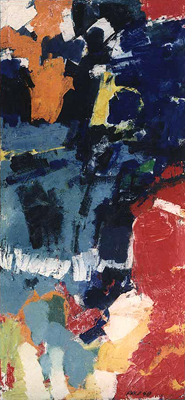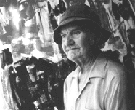
Stephen Pace (1918-)
“#82”
Signed “PACE ‘58” lower right,
oil on canvas 87 ½ x 40 ¾ inches.
NFS
boyce@karlie.com
 “I knew if I went back to the Midwest they’d put me to work on the farm, so I flipped a coin, heads, New York, tails, San Francisco.” New York won. “I was in a hurry after five years in the service, so I would just push paint around the canvas, blobs of color, until figures would emerge. I couldn’t understand why those blobs of color looked so good to me, but somehow the figure had left me. I didn’t consciously leave it.”
“I knew if I went back to the Midwest they’d put me to work on the farm, so I flipped a coin, heads, New York, tails, San Francisco.” New York won. “I was in a hurry after five years in the service, so I would just push paint around the canvas, blobs of color, until figures would emerge. I couldn’t understand why those blobs of color looked so good to me, but somehow the figure had left me. I didn’t consciously leave it.”
-Stephen Pace
Biography:
Stephen Pace was born on December 12, 1918 in Deventer, a small town in southeast Missouri near the Mississippi River. Subsequently, he lived in various towns in Indiana.
His formal art education began at the age of seventeen when he studied with Robert Lahr, an artist from Evansville, Indiana who helped Pace achieve a high degree of mastery in drawing and watercolor. In World War II Pace was stationed in England where he painted watercolors of local scenes in his free time. After the war he returned to Indiana and his studies with Lahr.
At 27, he decided to go to Mexico on the G.I. Bill and enrolled in the Institute of Fine Arts in San Miguel Allende. On his way back from Mexico after a year of study, Stephen Pace chose to go to New York where he studied at the Art Students League in 1948-49. From New York, he traveled to Florence in 1950 and studied at the Academie de la Grande Chaumiere in Paris in 1951.
After his studies abroad, he returned to New York and immersed himself in Abstract Expressionism and the Hofmann School. Hans Hofmann's precepts clearly influenced Pace's work. In the 1950’s, his artistic output depicted the importance of the space outside the rectangle, the structuring with color, the enhancement of both visual and visceral impressions, and the spatial tensions between areas of bright primary colors. These beliefs established Pace’s individuality and exhibited a spontaneous output based on both discipline and preparation.
During this time, Pace showed at the Whitney annuals and at the artist-run invitations, at the Stable Galley. He frequented local artist's taverns and became good friends with Franz Kline.
In the 1960’s he continued to not only explore his own possibilities and talents but also to instruct students at various prestigious universities such as University of California at Berkeley and American University.
His work is included in the public collections of the Metropolitan Museum of Art, the Hirshorn Museum, and the Corcoran Gallery.
